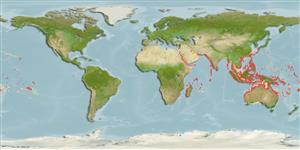Common names from other countries
>
Eupercaria/misc (Various families in series Eupercaria) >
Lutjanidae (Snappers) > Lutjaninae
Etymology: Lutjanus: Malay, ikan lutjan, name of a fish.
More on author: Forsskål.
Environment: milieu / climate zone / depth range / distribution range
Ecologia
marinhas; estuarina associadas(os) a recifes; intervalo de profundidade 3 - 35 m (Ref. 9710). Tropical; 31°N - 35°S, 20°E - 134°W (Ref. 55)
Indo-Pacific: Red Sea (Ref. 4320), Persian Gulf (Ref. 94051) and East Africa to Samoa, north to the Ryukyu Islands, south to Australia.
Comprimento de primeira maturação / Tamanho / Peso / Idade
Maturity: Lm 19.1, range 12 - ? cm
Max length : 50.0 cm TL macho/indeterminado; (Ref. 129178); common length : 30.0 cm TL macho/indeterminado; (Ref. 5450); idade máx. registrada: 23 anos (Ref. 2290)
Espinhos dorsais (total): 10; Raios dorsais (total): 12-14; Espinhos anais 3; Raios anais : 8. This species is distinguished by the following characters: body moderately deep; greatest depth 2.6-2.9 in SL; preopercular notch and knob poorly developed; vomerine tooth patch triangular or diamond-shaped, with a medial posterior extension; gill rakers of first gill arch 6-7 + 9-12 (including rudiments) = 16-19; caudal fin truncate to slightly emarginate; scale rows on back rising obliquely above lateral line. Colour of back and upper sides brown, lower sides whitish or light brown and belly whitish to yellow, usually a series of 6-7 yellow stripes on the sides and a prominent black spot at level of lateral line, below base of anterior part of soft portion of dorsal fin (Ref. 9821, 90102).
Adults inhabit coral reefs (Ref. 30573, 58652), usually in schools on coastal reefs and in deep lagoons (Ref. 48635). Often in large aggregations with Lutjanus kasmira and Lutjanus lutjanus (Ref. 9710). Juveniles are sometimes found in mangrove estuaries or in the lower reaches of freshwater streams. Feed mainly on fishes, shrimps, crabs and other crustaceans (Ref. 30573). Caught mainly with handlines, traps, and gill nets. A small species, commonly utilized in subsistence fisheries but also seen frequently in markets where it is sold usually fresh (Ref. 9821). Neither anterolateral glandular groove nor venom gland is present (Ref. 57406, information in the table as dangerous fish, does not match; needs verification).
Allen, G.R., 1985. FAO Species Catalogue. Vol. 6. Snappers of the world. An annotated and illustrated catalogue of lutjanid species known to date. FAO Fish. Synop. 125(6):208 p. Rome: FAO. (Ref. 55)
Status na Lista Vermelha da UICN (Ref. 130435)
CITES (Ref. 128078)
Not Evaluated
Ameaça para os humanos
Reports of ciguatera poisoning (Ref. 30298)
Uso pelos humanos
Warning: mysqli::__construct(): (HY000/1040): Too many connections in /var/www/html/includes/func_getlabel.php on line 46
Can't connect to MySQL database (fbapp). Errorcode: Too many connections
